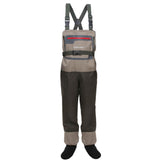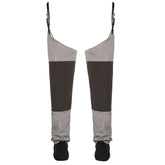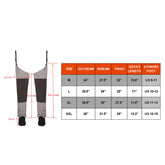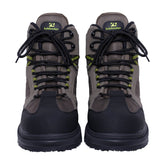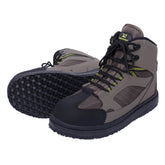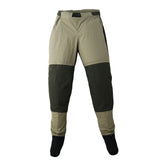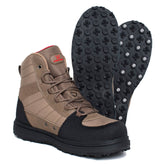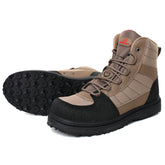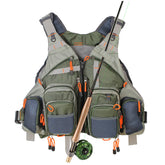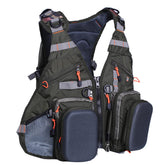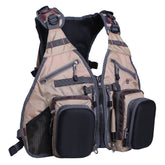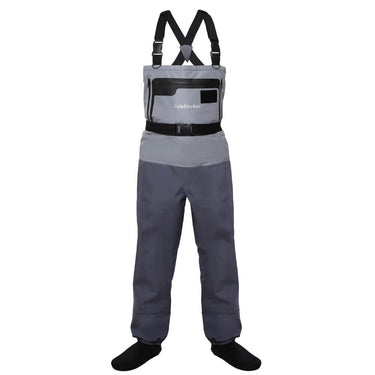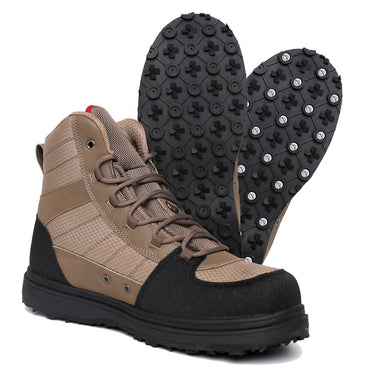Can You Fly Fish in Windy Conditions? (7 Tips to Cast in Wind)
Wind conditions can make it hard to fly fish for most people, especially those who are new to the sport. When the wind is too strong, it can cause problems casting your line. One of the most common reasons for knotting is to try and overcome the issue by using the wrong casting technique.
Wind conditions can be ideal for fishing. Those ripples in the water can help hide a fly fisher and improve your chances of landing a catch.
But, before you can start fishing in windy conditions, you need to make sure that you have the proper technique. One of the most important factors that you should consider is the type of flies and equipment you'll be using. While a heavier setup is ideal, smaller ones can be used in windy conditions.
Although it can be challenging to fly fish in windy conditions, it can be the best time to practice this technique. In this article, we'll talk about how to do it successfully and show you why it can be very productive.
CAN YOU FLY FISH IN WINDY CONDITIONS?
When it starts to get windy, you might hear the phrase "when it blows, let's find a place to fish out in this wind." This is a common mistake that new fly fishers make when they first start fishing in windy conditions. They might even say it to their fellow anglers, who are already experienced in the sport. However, this is not the best idea, as wind can be the enemy that you face in the water if you are not an experienced fly fisher.
Casting when the wind is strong can be very disappointing, especially for new anglers. Not having the proper technique can prevent you from delivering the right fly to the right spot. With that in mind, before you try out this technique, it's important that you have the necessary skills to make it work. Besides casting, it's also important to consider other factors such as how you'll be positioned in the water.
By learning how to cast against the wind and keep your body centered so that you don't get hit by the line, you can expect to land many fish. Having the proper planning will allow you to have a great fishing experience.
WHY IS WINDY WEATHER IDEAL FOR FLY FISHING?
The wind can have both negative and positive effects on your casting skills depending on your experience level. In some cases, it can even endanger your life when you're out fishing. It's important to avoid strong winds, as they can make it hard for you to operate safely and effectively.
Although it's possible to have a fan under the most moderate winds, it's important to remember that not every day will be peaceful. Therefore, before you start fishing in windy conditions, it's important that you have the necessary skills to make it work. Learning all the techniques required for casting against the wind can help improve your experience.
1. Stealth
When it comes to fishing, covertness is very important as any sudden movement can scare away the fish, which can prevent them from biting. After you've spotted a school of fish, you have to sneak up on them by casting your line near their location. This can be done by wearing a variety of clothing, including walking quietly. Unfortunately, going unnoticed by the fish every time you target them can be incredibly difficult. However, by throwing wind into the equation, you'll be able to alter everything.
The wind can also disturb the surface of the water, which can make it hard for the fish to see you. The more complex the wind blows, the more choppier the water will get. Although casting and spotting can be challenging, the fish will still be able to see you with the strong winds.
2. Food/Oxygen
The wind can also help improve the conditions of the water by making it more conducive to the growth and activity of fish. In addition, it can attract various food sources, such as plankton and insects. When the wind blows in a certain area, the fish will move to that part of the water to find food.
One of the best reasons to fish on a shoreline instead of in a calm lake is because the wind can blow various insects into the water. This can create a huge feast for the fish.
The chop and turbulence in the water can also make it hard for the fish to see you. This is because the fish will be more focused on the food sources in the lake. Also, the fact that they're easy to catch makes them a good target.
3. Water Color Transitions
Sometimes, fishing in windy conditions can lead to some of my favorite fishing spots, which are often mud lines. These are bands of dirty water that can extend for a couple of feet away from the shorelines. They usually form due to the flowing silt and the wind wave.
If you're planning on fishing near the shorelines of a lake, avoid the area's brown water color. However, a well-established mud line can be a great lure for fish.
In California, some lakes have mud lines that appear in the early afternoon. Although the shorelines may seem clear in morning, the brown bands can appear near the banks as boats hit the water, creating a unique fish magnet. Even though fishing may slow down in the afternoon, mud lines can still provide an exceptional experience.

Dirty water can also be used by fish to hide and ambush their prey. The water flowing on the bank can create a great environment for catching trophy fish. Largemouth bass and stripers often get aggressive when they're patrolling the edges of the mud lines.
Although it can take a long time for a mud line to develop, it will eventually become a great lure for fish once it starts to bite. This is why it's important to fish along the edges of the lines.
HOW FAR DO I HAVE TO CAST WHEN IT’S WINDY?
When the wind blows at a windy time, you'll often see fish coming to the surface of the water to feed. Some anglers even caught trout without casting lines. This is because, during windy conditions, the fish can be within the line's length.
In most cases, a simple roll or flick cast is all that's needed to get the job done. A long line can also be a great lure when the wind is strong. This is because, if you put a long line, you'll be able to pull flies through the water and attract more fish.

7 TIPS TO CAST IN WIND
No one likes windy days, especially when it's windy and you're left alone fishing in the pristine waters. Unfortunately, casting a line with a sharp hook can be very risky. Fortunately, with the right technique, you can safely cast your line and catch a fish in no time.
1. Get a Heavier Fly Rod (with a heavier line)
Most fly anglers agree that a 5wt fly rod is a great all-around fly rod for catching trout. However, if you're planning on fishing in windy conditions, we recommend using a 6wt fly rod instead. This type of rod has a stronger and more powerful feel, which will allow you to cast through the wind more efficiently.
2. Get a Fast-Action Rod
Since you're planning on using a large dry fly, we recommend using a fast-action rod instead. This type of rod can help you cast through the wind and deal with larger fish species.
3. Use Weighted Fly Lines
Although light lines are usually easy to cast, casting them in windy conditions can be very challenging. This is why we highly recommend using a weighted line. This type of line will allow you to cast your line more efficiently and effectively.
Although some plastic weighted lines are half-weight heavier, we highly recommend using a heavier one if you can't find one. This type of line will allow you to use more power and deliver a more accurate and powerful fly. If you're planning on fishing in windy conditions, you can also reduce the leaders by about a foot.
4. Perfect Your Double Haul Cast
Casting in windy conditions can be very frustrating, especially if you're using big flies and your usual technique. This is why I recommend learning how to cast in windy conditions and practicing double-haul techniques. It's the most effective technique when fishing in areas with strong winds.
The law of energy conservation states that an isolated system's energy can never be destroyed, and it can only be transferred. With the use of a weighted line, the top tip of the line moves in the other direction, demonstrating Newton's third law.
The flexibility of a rod allows it to store energy as kinetic energy. When it bends, the more potential energy it has, which then allows the line to continue casting. One of the most effective ways to achieve this is by practicing double-haul techniques.
When performing double-haul techniques, the second line must be used to pull the rod back or forward while the casting hand must be used to move it. This bending will increase the rod's potential energy, which will allow you to use more power.
5. Use a Simple Roll Cast When Casting Near the Boat or Shoreline
Although there are many techniques that can work when it comes to casting in windy conditions, the roll cast is the most safe and effective method. This type of technique will allow you to reach the fish near your boat.
The roll cast is a simple technique that features only one cast. It's regarded as one of the most popular and straightforward casting techniques, and it can help you overcome any obstacle that might prevent you from casting properly.
6. Where Should I Stand When Casting Against the Wind?
The positioning of the rod is also important when casting in windy conditions. Since no one likes to have their head pierced by a sharp hook, it's important that you consider your safety when it comes to casting. When casting in windy conditions, the wind must blow the hook away from the body to avoid injury.
When using the right hand, the wind must blow to the side of your shoulder so that the fly will not get blown away from your body. When casting with the left hand, the wind should blow to the side of your shoulder so that the fly will not get blown away. Doing this can be a safer technique as it allows the fly to move further.
One of the most effective ways to catch fish in windy conditions is by casting to areas where the wind is blowing. This will allow you to target areas where the food is located and where you can find your prized fish. However, this method can be a bit challenging as it requires you to fish across the wind.
7. How Do I Reduce Tangles When Fishing in Gusty Conditions?
Most experienced anglers agree that it can be easier to cast in windy conditions than you think. They recommend using a heavier tippet and leader than you usually would. A longer and lighter leader made from a finer line is more likely to keep tangles at a safer distance.
For optimal performance when fishing in windy conditions, you should use a heavier tippet and a lighter butt section. These items can help minimize the likelihood of tangles and allow you to easily turn the fly over. A 15 pound leader can also help you keep catching fish in windy conditions.
What Wind Directions Should You Avoid When Fishing in Windy Conditions?
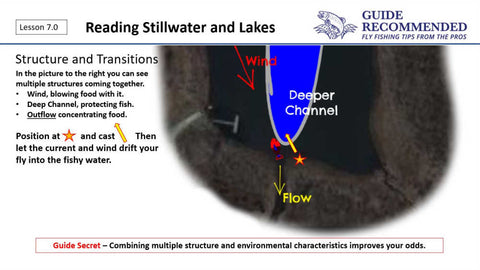
Reading the Water for Lakes and Positioning
The wind can also pose a threat when it comes to fishing because it can blow the hook directly towards your body. This is why it's important that you practice your body position properly.
Although most anglers prefer to cast in the wind direction that's perpendicular to the body, some experienced anglers prefer to use an overhead casting technique. This method involves stopping the rod in a vertical position so that the back cast will move upwards. To make this happen, let the line roll before driving the rod down.
A tailwind can add an unwanted amount of speed to your forward cast, especially when using a heavy fly and a weighted line. If done correctly, a tailwind can assist in casting your line further.
Casting can become a bit challenging when the wind blows directly towards your body. One of the best ways to avoid this issue is to keep the line away from your body. If the wind is blowing on the other side, you can try lowering the tip of your rod to make a relaxed cast.
LAST CAST (INTO THE WIND)
Before you start fishing, it's important that you thoroughly prepare for the weather conditions. Besides preparing your equipment, it's also important that you practice casting techniques in order to get the most out of the wind. Having the proper technique and body positioning can help you cast successfully in windy conditions.
Article refer:
1.Basic Fly Casting Techniques -Two Stroke Casting
2.Various Types of Fly Fishing Haul Casting Techniques
3.Some Roll Casting Technique For Beginner
4 tips for beginner musky anglers
5.Favorite Fly Patterns for Lakes
6.Can You Fly Fish in Windy Conditions? (7 Tips to Cast in Wind)
7.What equipment is needed for fly fishing for sockeye salmon?
8.How to prepare fly fishing gear for striped bass?
9.The Five Stages of Fly Fishing
10.Flying gear: six fishermen necessities
